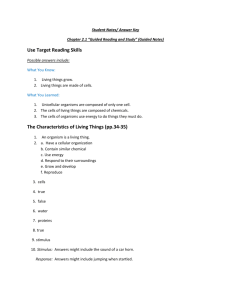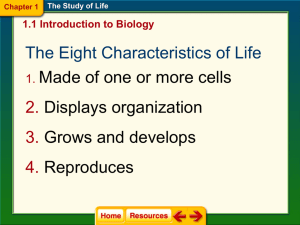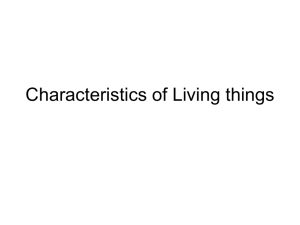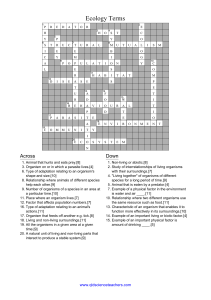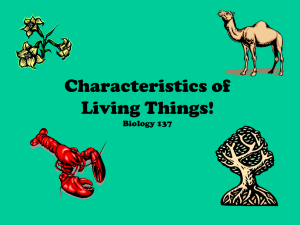1.1 What is biology?
advertisement
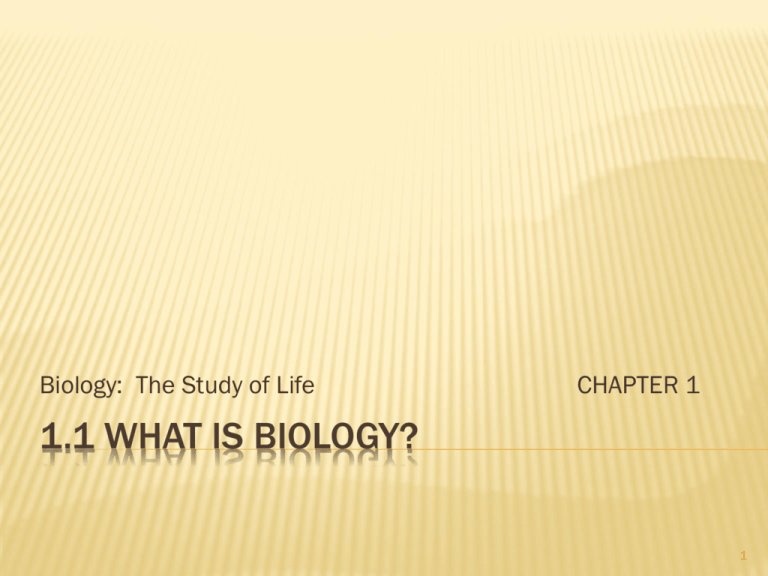
Biology: The Study of Life CHAPTER 1 1.1 WHAT IS BIOLOGY? 1 1.1 BIOLOGISTS STUDY THE DIVERSITY OF LIFE Biology = the study of life Interactions of Life Living things do not exist isolated from other living things. Living things interact with other living and non-living things within their environment. 2 1.1 BIOLOGISTS STUDY THE DIVERSITY OF LIFE Biologists study the diversity of life… Learning about the world of living things in our environment… Biologists study the interactions of the environment. Since no living thing exists in isolation, we must study their interactions with other living things and non-living components in their environment. Population of rabbits: what they eat, and what eats them Humans? What are our interactions within our environments? 3 1.1 BIOLOGISTS STUDY THE DIVERSITY OF LIFE Biologists study problems and propose solutions. Water pollution Air pollution Over-fishing Deforestation Acidity of our water Illness Etc... 4 1.1 CHARATERISTICS OF LIVING THINGS All living things: Have an orderly structure Produce offspring Grow and develop Adjust to changes in the environment 5 1.1 CHARACTERISTICS OF LIVING THINGS Living things are organized. Orderly structure = organization 1+ cells Each cell contains the genetic material (DNA), which provides all the information necessary to control the life processes of an organism. Living things are unified in having cellular organization. All of the parts of a cell, whether single cell, or multi-cell, function together in an orderly, living system. 6 1.1 CHARACTERISTICS OF LIVING THINGS Living things make more living things. Reproduction = the production of offspring Organisms do not live forever. For life to continue, they must replace themselves. Reproduction is not essential for the survival of an individual organism, but it is essential for the continuation of the organism’s species. A species is a group of organisms that can interbreed and produce fertile offspring in nature. If a species did not reproduce, it would mean the end to that species’ existence on Earth. 7 1.1 CHARACTERISTICS OF LIVING THINGS Living things change during their lives. An organism’s life begins as a single cell. Over time, it grows and takes on the characteristics of its species. Growth = increase in the amount of living material and the formation of new structures Development = all of the changes that take place during the life of an organism Embryo – baby – toddler – child – adolescent – teenager – adult 8 1.1 LIVING THINGS ADJUST TO THEIR SURROUNDINGS Organisms live in a constant interface with their environment. The environment includes other living things, and also non-living things, such as: Air Water Earth Weather Temperature Etc… 9 1.1 LIVING THINGS ADJUST TO THEIR SURROUNDINGS Stimulus = anything in an organism’s external or internal environment that causes the organism to react Response = is a reaction to a stimulus i.e., The fox responds to the presence of a rabbit (the stimulus) by quietly moving toward it. If the rabbit spots the fox (now the fox is the stimulus), the rabbit will respond by hopping away… very quickly. 10 1.1 CHARACTERISTICS OF LIVING THINGS Homeostasis = regulation of an organism’s internal environment to maintain suitable conditions for its survival Water/mineral content within their cells Blood pressure Internal temperature pH Without the ability to adjust to internal changes, an organism would die. 11 1.1 CHARACTERISTICS OF LIVING THINGS Living things reproduce themselves, grow & develop, respond to external stimuli, and maintain homeostasis by using energy. Energy = is the ability to cause change. Organisms get their energy from food. Plants make their own food. Animals, fungi, other organisms get their food from plants or other organisms that consume plants. 12 1.1 CHARACTERISTICS OF LIVING THINGS Living things adapt and evolve. Adaptation = any inherited structure, behavior, or internal process that enables an organism to respond to environmental factors and live to reproduce Adaptations are inherited from previous generations. There are some differences in the adaptations of individuals within a population of organisms. 13 1.1 CHARACTERISTICS OF LIVING THINGS As an environment changes, some adaptations are better suited to the new conditions than others. Organisms with better suited adaptations are more likely to survive and reproduce. Individuals with these adaptations become more numerous in the population. 14 1.1 CHARACTERISTICS OF LIVING THINGS Evolution = gradual change in a species through adaptations over time Clues to the diversity of life may be understood by the study of evolution. 15
